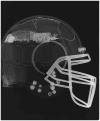Biomechanical properties of concussions in high school football
- PMID: 20351593
- PMCID: PMC2943536
- DOI: 10.1249/MSS.0b013e3181dd9156
Biomechanical properties of concussions in high school football
Abstract
Introduction: Sport concussion represents the majority of brain injuries occurring in the United States with 1.6–3.8 million cases annually. Understanding the biomechanical properties of this injury will support the development of better diagnostics and preventative techniques.
Methods: We monitored all football related head impacts in 78 high school athletes (mean age = 16.7 yr) from 2005 to 2008 to better understand the biomechanical characteristics of concussive impacts.
Results: Using the Head Impact Telemetry System, a total of 54,247 impacts were recorded, and 13 concussive episodes were captured for analysis. A classification and regression tree analysis of impacts indicated that rotational acceleration (95582.3 rad·s−²), linear acceleration (996.1g), and impact location (front, top, and back) yielded the highest predictive value of concussion.
Conclusions: These threshold values are nearly identical with those reported at the collegiate and professional level. If the Head Impact Telemetry System were implemented for medical use, sideline personnel can expect to diagnose one of every five athletes with a concussion when the impact exceeds these tolerance levels. Why all athletes did not sustain a concussion when the impacts generated variables in excess of our threshold criteria is not entirely clear, although individual differences between participants may play a role. A similar threshold to concussion in adolescent athletes compared with their collegiate and professional counterparts suggests an equal concussion risk at all levels of play.
Figures
References
-
- American Academy of Neurology. Practice Parameter: The management of concussion in sports (summary statement). Report of the Quality Standards Subcommittee of the American Academy of Neurology. Neurology. 1997;48(3):581–5. - PubMed
-
- Arbogast KB, Margulies SS. A fiber-reinforced composite model of the viscoelastic behavior of the brainstem in shear. J Biomech. 1999 Aug;32(8):865–70. - PubMed
-
- Bauer JA, Thomas TS, Cauraugh JH, Kaminski TW, Hass CJ. Impact forces and neck muscle activity in heading by collegiate female soccer players. J Sports Sci. 2001;19 (3):171–9. - PubMed
-
- Breiman L, Friedman J, Stone CJ, Olshen RA. Classification and Regression Trees. 1984:1–168.
MeSH terms
Grants and funding
LinkOut - more resources
Full Text Sources
Other Literature Sources
Medical



